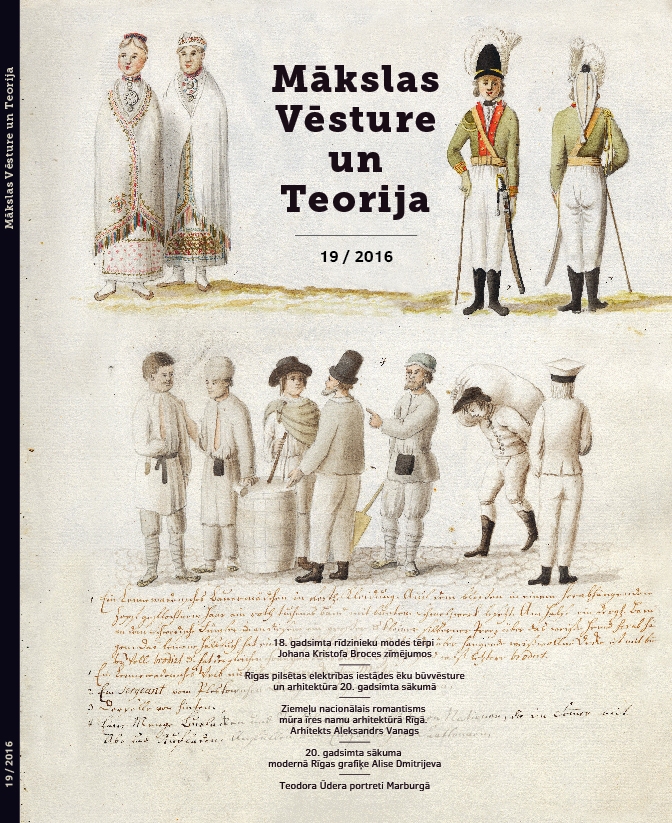20. gadsimta sākuma modernā Rīgas grafiķe Alise Dmitrijeva
Early 20th Century Riga’s Modern Graphic Artist Alice Dmitrijew
Author(s): Baiba VanagaSubject(s): Cultural history, Visual Arts, Pre-WW I & WW I (1900 -1919)
Published by: Mākslas vēstures pētījumu atbalsta fonds
Keywords: Alice Dmitrijew; Baltic German art; graphics; woodcut; Art Nouveau;
Summary/Abstract: In autumn 1911, Alice Dmitrijew (1876–1945) showed her decorative, stylised colour woodcuts for the first time to the public of her native Riga at the 2nd exhibition of the Baltic Artists’ Association in the Riga Art Society premises. Existing publications, mainly artists’ dictionaries, provide very little information on her biography, largely containing birth and death years, some facts and short descriptions of her graphic works but nothing about her education. Also early 20th century local periodicals give only descriptions of works shown in exhibitions and individual reproductions. Significant hints of a more comprehensive biography have been found in a letter by the Riga-born German Margot Mecketh (1889–1956) to Paul Campe (1885–1960) preserved in the legacy of this architect and historian of architecture at the Herder Institute in Marburg and so far unknown to Latvian researchers. Alice Dmitrijew was born in Riga on 23 June (5 July) 1876 to the family of Ivan Dmitrijew (1841 or 1842–1914), a merchant from Yaroslavl and active member of the city’s Russian community, and his wife Alice (b. Alice Meshit, widowed Wilhelmson, 1840 or 1841–1878), a Riga-born descendant of a Silesian weavers’ family. The future artist lost her mother early, received primary education with Russian tutors but later joined the Baltic German circles with the help of her mother’s relatives and friends. Dmitrijew probably began her artistic education at Elise von Jung-Stilling’s (1829–1904) Drawing School in the late 1890s but later together with Anna Hellmann (married Schewitz, 1876–1932) perfected her knowledge in Germany. There both budding artists possibly attended the so-called Debschitz School (Debschitz-Schule) or Studio for Training and Experiments in Applied and Free Arts (Lehr- und Versuchs-Atelier für angewandte und freie Kunst) in Munich for some time around 1904–1905. Having met Rainer Maria Rilke, they spent the summer of 1905 painting at the Worpswede artists’ colony. After returning to her homeland, Dmitrijew became acquainted with her future close friend, painter, craftswoman and critic Susa Walter (1874–1945) who had studied in Tartu and Berlin; she had recently moved to Riga and opened her studio there. Dmitrijew, along with other young artists, practiced fine and applied arts there and explored art history at regular lectures. Dmitrijew got involved with the regional artistic life, joining the Women Artists’ Club (Künstlerinnen-Klub) together with other local activists as well as participating in exhibitions on a regular basis since 1910. She exhibited her works at the shows of the Baltic Artists’ Association in Kuldīga (1910, 1911, 1912), Riga (1911, 1913, 1918), Pärnu (1911) and Tallinn (1912), also taking part in other exhibitions of fine and applied arts in Riga (1915, 1917) and Tallinn (1911, 1918). In January 1918, Dmitrijew together with Susa Walter and Nora Ruthenberg (b. Umblia, 1890–1974) organised an exhibition in a house at Smilšu Street, all three exhibiting about 200 paintings, woodcuts and drawings. Dmitrijew most often exhibited colour woodcuts in local art shows, being one of the first Baltic artists to take up print techniques seriously; she largely earned positive reviews in both the German and Latvian press. However, today we know just twelve woodcuts from the print collection of the Latvian National Museum of Art, one painting that has recently surfaced in the art market, one cover design for a book and several reproductions in the Yearbook of Baltic Art (Jahrbuch für bildende Kunst in den Ostseeprovinzen).Dmitrijew’s preserved works, all dated about 1910–1915, feature typical Art Nouveau interplays of rhythmical areas and a refined, subdued colour range. In this period she had used simple compositions, laconic, generalised and unified colour fields and subtle tonal variations to create decorative, moderately elegant and sometimes playfully fresh interpretations of figural, landscape and still life motifs. In still lifes, her favourite motif was simple compositions with flowers of one sort and colour in vases of different forms; similar motifs also feature in the works of Martha Hellmann (1873–1972) and Susa Walter realised in other techniques. But the known landscape motifs are almost all dissimilar. They include a bumpy forest road leading towards a contrasting bright blue distance, a fragmentarily captured dune hill with pine trunks, a couple of more uniformly coloured and spatially broader dune scenes as well as an urban motif with the fragmentary Vasily the Blessed Cathedral in Moscow. Dmitrijew’s stylised and very decoratively treated figural genre compositions were highly original in comparison to other local artists’ works of the time. Figures are mostly pictured from a side view, caught in rather tense, seated positions and rendered with silhouettes in nuanced, graded tones, often emphasising decorativeness with juxtaposed colour fields or ornamental décor. About 1919–1920, Dmitrijew moved to Berlin where she launched and headed a studio of applied arts together with Susa Walter. In the mid-1930s she returned to Latvia but did not join in the local artistic life any more and left her homeland in autumn 1939 along with many other German-origin inhabitants of Latvia. In December 1945, Dmitrijew died in Selz refugee camp in Germany not far from Altentreptow, and almost all of her creative legacy perished during the war.
Journal: Mākslas Vēsture un Teorija
- Issue Year: 2016
- Issue No: 19
- Page Range: 48-62
- Page Count: 15
- Language: Latvian
- Content File-PDF

